12-2: Configuring the CSC SSM
![]() The Content Security and Control (CSC) SSM was introduced with ASA release 7.1(1). The CSC is used in conjunction with the ASA to provide a variety of inspections and defenses based on traffic content.
The Content Security and Control (CSC) SSM was introduced with ASA release 7.1(1). The CSC is used in conjunction with the ASA to provide a variety of inspections and defenses based on traffic content.
![]() The CSC communicates with the ASA over an internal backplane connection. Figure 12-3 shows how traffic is passed between the ASA and CSC. The ASA diverts traffic classified by a class map to the CSC module over the internal connection. The CSC inspects the traffic in both the forward and return directions so that it can block or modify the contents.
The CSC communicates with the ASA over an internal backplane connection. Figure 12-3 shows how traffic is passed between the ASA and CSC. The ASA diverts traffic classified by a class map to the CSC module over the internal connection. The CSC inspects the traffic in both the forward and return directions so that it can block or modify the contents.
![]() CSC SSM cannot support stateful failover because it does not maintain connection information about the traffic it inspects. Therefore, it cannot provide the failover unit with information necessary for stateful failover.
CSC SSM cannot support stateful failover because it does not maintain connection information about the traffic it inspects. Therefore, it cannot provide the failover unit with information necessary for stateful failover.
![]() The connections that a CSC SSM is scanning are dropped upon failure of the security appliance in which the CSC SSM is installed. When the standby ASA becomes active, it forwards the scanned traffic to its own CSC SSM, and any existing connections are reset.
The connections that a CSC SSM is scanning are dropped upon failure of the security appliance in which the CSC SSM is installed. When the standby ASA becomes active, it forwards the scanned traffic to its own CSC SSM, and any existing connections are reset.
 Configuring the ASA to Divert Traffic to the CSC SSM
Configuring the ASA to Divert Traffic to the CSC SSM
![]() As you work through initially installing and configuring your CSC SSM, keep in mind that the ASA and CSC SSM are essentially two independent pieces of hardware. Even though the CSC lives in an SSM slot on the ASA chassis, the two communicate over an out-of-band connection only for basic setup and status information. Even though the CSC SSM is installed and the ASA sees it as an active module, the ASA does not send any traffic to the CSC until you configure it to do so.
As you work through initially installing and configuring your CSC SSM, keep in mind that the ASA and CSC SSM are essentially two independent pieces of hardware. Even though the CSC lives in an SSM slot on the ASA chassis, the two communicate over an out-of-band connection only for basic setup and status information. Even though the CSC SSM is installed and the ASA sees it as an active module, the ASA does not send any traffic to the CSC until you configure it to do so.
![]() Any type of traffic traveling in any direction can be diverted to the CSC. For example, you can configure the ASA to send all traffic to the CSC for inspection. However, the CSC can inspect only the following types of traffic:
Any type of traffic traveling in any direction can be diverted to the CSC. For example, you can configure the ASA to send all traffic to the CSC for inspection. However, the CSC can inspect only the following types of traffic:
-
 Simple Mail Transfer Protocol (SMTP)— TCP port 25
Simple Mail Transfer Protocol (SMTP)— TCP port 25 -
 Post Office Protocol version 3 (POP3)— TCP port 110
Post Office Protocol version 3 (POP3)— TCP port 110 -
 Hypertext Transfer Protocol (HTTP)— TCP port 80
Hypertext Transfer Protocol (HTTP)— TCP port 80 -
 File Transfer Protocol (FTP)— TCP port 21
File Transfer Protocol (FTP)— TCP port 21
![]() If you send any other types of traffic, the CSC is forced to look at those packets, discovers that they are not of the supported types, and ignores them. In other words, the CSC should not have to waste its time and resources looking at traffic it cannot inspect anyway.
If you send any other types of traffic, the CSC is forced to look at those packets, discovers that they are not of the supported types, and ignores them. In other words, the CSC should not have to waste its time and resources looking at traffic it cannot inspect anyway.
![]() Instead, you should identify only the types of traffic that can be inspected in your network setting. For example, if you have SMTP servers inside your network, then you should divert SMTP traffic to the CSC. If you do not have FTP servers, then do not divert FTP traffic to the CSC.
Instead, you should identify only the types of traffic that can be inspected in your network setting. For example, if you have SMTP servers inside your network, then you should divert SMTP traffic to the CSC. If you do not have FTP servers, then do not divert FTP traffic to the CSC.
![]() In addition, think about the direction that the inspected traffic is traveling. If you have an SMTP server inside your network, chances are that e-mail is reaching your users as SMTP packets traveling inbound to the server. Therefore, inbound SMTP should be diverted to the CSC so that inbound spam, viruses, and other malware can be detected on the way into your network. Most of the configuration examples shown in the Cisco documentation show only inbound SMTP diverted to a CSC. However, you might also want to divert outbound SMTP to the CSC, to detect and prevent any spam being sourced by your internal users.
In addition, think about the direction that the inspected traffic is traveling. If you have an SMTP server inside your network, chances are that e-mail is reaching your users as SMTP packets traveling inbound to the server. Therefore, inbound SMTP should be diverted to the CSC so that inbound spam, viruses, and other malware can be detected on the way into your network. Most of the configuration examples shown in the Cisco documentation show only inbound SMTP diverted to a CSC. However, you might also want to divert outbound SMTP to the CSC, to detect and prevent any spam being sourced by your internal users.
![]() Traffic is diverted to the CSC through a service policy that is applied to a firewall interface. As with any service policy, interesting traffic must be grouped into a traffic class, and a specific action must be taken. In this case, the traffic class is defined by an access list. The goal is to have one unique service policy applied to each firewall interface for traffic entering that interface. For example, you might have the following service policies:
Traffic is diverted to the CSC through a service policy that is applied to a firewall interface. As with any service policy, interesting traffic must be grouped into a traffic class, and a specific action must be taken. In this case, the traffic class is defined by an access list. The goal is to have one unique service policy applied to each firewall interface for traffic entering that interface. For example, you might have the following service policies:
|
|
|
|
|---|---|---|
|
|
|
|
|
|
|
|
|
|
|
|
![]() You can use the following steps to configure and apply a service policy on a firewall interface. Repeat these steps for other interfaces:
You can use the following steps to configure and apply a service policy on a firewall interface. Repeat these steps for other interfaces:
-
 Identify traffic with an access list.
Identify traffic with an access list. Create an access list with an arbitrary name. You should permit traffic to be diverted to the CSC and deny traffic that does not need to be inspected. For inbound traffic on the outside interface, you can use the following template:
Create an access list with an arbitrary name. You should permit traffic to be diverted to the CSC and deny traffic that does not need to be inspected. For inbound traffic on the outside interface, you can use the following template: Firewall(config)# access-list acl_name_inbound permit tcp any inside_subnet eq 80
Firewall(config)# access-list acl_name_inbound permit tcp any inside_subnet eq 80
Firewall(config)# access-list acl_name_inbound permit tcp any inside_smtp_address eq 25 For outbound traffic on the inside interface, you can use the following template:
For outbound traffic on the inside interface, you can use the following template: Firewall(config)# access-list acl_name_outbound permit tcp inside_subnet inside_mask
Firewall(config)# access-list acl_name_outbound permit tcp inside_subnet inside_mask
any eq 80
Firewall(config)# access-list acl_name_outbound permit tcp inside_subnet inside_mask
any eq 25
Firewall(config)# access-list acl_name_outbound permit tcp inside_subnet inside_mask
any eq 110
Firewall(config)# access-list acl_name_outbound permit tcp inside_subnet inside_mask
any eq 21 -
 Group traffic into a class.
Group traffic into a class. Create a class map with an arbitrary name. This class contains all traffic in one direction only. The class matches against the access list created in Step 1. Use the following configuration commands to create the class map:
Create a class map with an arbitrary name. This class contains all traffic in one direction only. The class matches against the access list created in Step 1. Use the following configuration commands to create the class map: Firewall(config)# class-map class_map_name
Firewall(config)# class-map class_map_name
Firewall(config-cmap)# match access-list acl_name
Firewall(config-cmap)# exit -
 Define a policy to divert traffic to the CSC.
Define a policy to divert traffic to the CSC. Create a policy map that references the class map created in Step 2. The policy map acts on traffic in one direction only. The traffic is diverted to the CSC with the csc command. Use the following configuration commands to create the policy map:
Create a policy map that references the class map created in Step 2. The policy map acts on traffic in one direction only. The traffic is diverted to the CSC with the csc command. Use the following configuration commands to create the policy map: Firewall(config)# policy-map policy_map_name
Firewall(config)# policy-map policy_map_name
Firewall(config-pmap)# class class_map_name
Firewall(config-pmap-c)# csc {fail-close | fail-open}
Firewall(config-pmap-c)# exit
Firewall(config-pmap)# exit Use the fail-close keyword to make the ASA stop forwarding traffic if the CSC module fails. Otherwise, you can use the fail-open keyword to make sure the ASA keeps forwarding traffic during a CSC failure.
Use the fail-close keyword to make the ASA stop forwarding traffic if the CSC module fails. Otherwise, you can use the fail-open keyword to make sure the ASA keeps forwarding traffic during a CSC failure. -
 Apply the policy to a firewall interface.
Apply the policy to a firewall interface. Finally, apply the policy map created in Step 3 to a firewall interface using the following configuration command:
Finally, apply the policy map created in Step 3 to a firewall interface using the following configuration command: Firewall(config)# service-policy policy_map_name interface interface_name
Firewall(config)# service-policy policy_map_name interface interface_name
![]() The following commands represent a complete example of the configuration commands needed to divert interesting traffic to the CSC. Inbound traffic arriving on the firewall’s outside interface is matched with class map csc_inbound and handled by policy map csc_inbound_policy. Only inbound SMTP and HTTP traffic are diverted, assuming outside clients are sending mail and browsing web content on inside servers:
The following commands represent a complete example of the configuration commands needed to divert interesting traffic to the CSC. Inbound traffic arriving on the firewall’s outside interface is matched with class map csc_inbound and handled by policy map csc_inbound_policy. Only inbound SMTP and HTTP traffic are diverted, assuming outside clients are sending mail and browsing web content on inside servers:
Firewall(config)# access-list csc_inbound_divert extended permit tcp 192.168.100.0
255.255.255.0 any eq smtp
Firewall(config)# access-list csc_inbound_divert extended permit tcp 192.168.100.0
255.255.255.0 any eq www
!
Firewall(config)# class-map csc_inbound
Firewall(config-cmap)# match access-list csc_inbound_divert
Firewall(config)# exit
!
Firewall(config)# policy-map csc_inbound_policy
Firewall(config-pmap)# class csc_inbound
Firewall(config-pmap-c)# csc fail-close
Firewall(config-pmap-c)# exit
Firewall(config-pmap)# exit
!
Firewall(config)# service-policy csc_inbound_policy interface outside
![]() For outbound traffic arriving at the firewall’s inside interface, class map csc_outbound matches traffic and policy map csc_outbound_policy handles the traffic. Here, only outbound SMTP, POP3, HTTP, and FTP connections are diverted, assuming inside users are heading toward outside servers.
For outbound traffic arriving at the firewall’s inside interface, class map csc_outbound matches traffic and policy map csc_outbound_policy handles the traffic. Here, only outbound SMTP, POP3, HTTP, and FTP connections are diverted, assuming inside users are heading toward outside servers.
Firewall(config)# access-list csc_outbound_divert extended permit tcp 192.168.100.0
255.255.255.0 any eq smtp
Firewall(config)# access-list csc_outbound_divert extended permit tcp 192.168.100.0
255.255.255.0 any eq pop3
Firewall(config)# access-list csc_outbound_divert extended permit tcp 192.168.100.0
255.255.255.0 any eq www
Firewall(config)# access-list csc_outbound_divert extended permit tcp 192.168.100.0
255.255.255.0 any eq ftp
!
Firewall(config)# class-map csc_outbound
Firewall(config-cmap)# match access-list csc_outbound_divert
Firewall(config-cmap)# exit
!
Firewall(config)# policy-map csc_outbound_policy
Firewall(config-pmap)# class csc_outbound
Firewall(config-pmap-c)# csc fail-close
Firewall(config-pmap-c)# exit
Firewall(config-pmap)# exit
!
Firewall(config)# service-policy csc_outbound_policy interface inside
![]() Even though the CSC has not been configured at this stage, you should verify that the ASA is actually trying to divert traffic to it. You can do this by monitoring the access list counters, which are updated in real time. In the following example, the shaded output highlights the hit count for each access list entry, indicating the number of times a packet matched the condition:
Even though the CSC has not been configured at this stage, you should verify that the ASA is actually trying to divert traffic to it. You can do this by monitoring the access list counters, which are updated in real time. In the following example, the shaded output highlights the hit count for each access list entry, indicating the number of times a packet matched the condition:
Firewall# show access-list csc_outbound_divert
access-list csc_outbound_divert; 3 elements
access-list csc_outbound_divert line 1 extended permit tcp 192.168.100.0 255.255.255.0
any eq pop3 (hitcnt=479) 0x6dc20704
access-list csc_outbound_divert line 2 extended permit tcp 192.168.100.0 255.255.255.0
any eq www (hitcnt=1473) 0x94f0d51f
access-list csc_outbound_divert line 3 extended permit tcp 192.168.100.0 255.255.255.0
any eq ftp (hitcnt=16) 0x4f7313ea
Firewall#
 Configuring the Initial CSC SSM Settings
Configuring the Initial CSC SSM Settings
![]() The CSC SSM must be configured independently of the ASA. You can use several methods to connect to and configure the CSC. Most often, you use ASDM as your interface to the CSC, although other methods are discussed as they are needed. You should use the following steps to configure a CSC SSM:
The CSC SSM must be configured independently of the ASA. You can use several methods to connect to and configure the CSC. Most often, you use ASDM as your interface to the CSC, although other methods are discussed as they are needed. You should use the following steps to configure a CSC SSM:
-
 Verify the CSC SSM status.
Verify the CSC SSM status. After a CSC SSM is installed in an ASA chassis, you should verify that the module is powered up and available. You can do that with the show module ASA command, as shown in the following example. Here, the CSC SSM is listed as ASA module 1 in the “up” state.
After a CSC SSM is installed in an ASA chassis, you should verify that the module is powered up and available. You can do that with the show module ASA command, as shown in the following example. Here, the CSC SSM is listed as ASA module 1 in the “up” state. Firewall# show module
Firewall# show module
Mod Card Type Model Serial No.
--- -------------------------------------------- ------------------ -----------
0 ASA 5510 Adaptive Security Appliance ASA5510 JMX1014K070
1 ASA 5500 Series Content Security Services Mo ASA-SSM-CSC-10 JAF10252436
Mod MAC Address Range Hw Version Fw Version Sw Version
--- --------------------------------- ------------ ------------ ---------------
0 0016.c789.c8a4 to 0016.c789.c8a8 1.1 1.0(10)0 7.2(1)
1 0018.7317.8eb3 to 0018.7317.8eb3 1.0 1.0(11)2 CSC SSM 6.1
(Build#1519)
Mod SSM Application Name Status SSM Application Version
--- ------------------------------ ---------------- --------------------------
1 CSC SSM Up 6.1 (Build#1519)
Mod Status Data Plane Status Compatibility
--- ------------------ --------------------- -------------
0 Up Sys Not Applicable
1 Up Up
Firewall# -
 The CSC SSM must be configured with some initial information, such as an IP address, basic network settings, and license keys, before it can begin to operate. You should attempt to configure these settings through ASDM first, before trying any other methods.
The CSC SSM must be configured with some initial information, such as an IP address, basic network settings, and license keys, before it can begin to operate. You should attempt to configure these settings through ASDM first, before trying any other methods. Within ASDM, click on the Configuration tab at the top of the screen. Then click on the Trend Micro Content Security button on the left side of the screen. If the CSC SSM has never been configured before, you should see the CSC Setup Wizard window appear, as shown in Figure 12-4.
Within ASDM, click on the Configuration tab at the top of the screen. Then click on the Trend Micro Content Security button on the left side of the screen. If the CSC SSM has never been configured before, you should see the CSC Setup Wizard window appear, as shown in Figure 12-4.
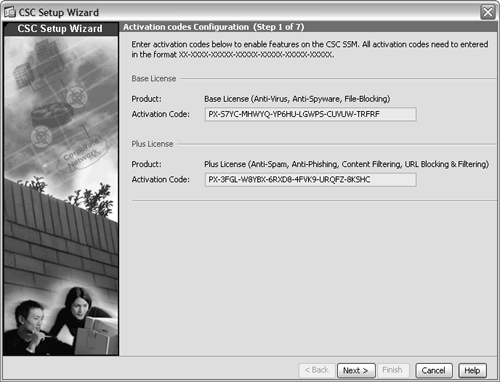
 Figure 12-4: The CSC Setup Wizard Begins the Initial Configuration
Figure 12-4: The CSC Setup Wizard Begins the Initial Configuration  If you see a window titled Connecting to CSC..., as shown in Figure 12-5, instead of the CSC Setup Wizard, the CSC SSM has probably been previously configured. The ASDM fetches the last known management interface IP address from the CSC and offers to use it. If you do not recognize the management IP address, you need to reconfigure the IP address information. Refer to the section “Repairing the Initial CSC Configuration” in this chapter for more information.
If you see a window titled Connecting to CSC..., as shown in Figure 12-5, instead of the CSC Setup Wizard, the CSC SSM has probably been previously configured. The ASDM fetches the last known management interface IP address from the CSC and offers to use it. If you do not recognize the management IP address, you need to reconfigure the IP address information. Refer to the section “Repairing the Initial CSC Configuration” in this chapter for more information.
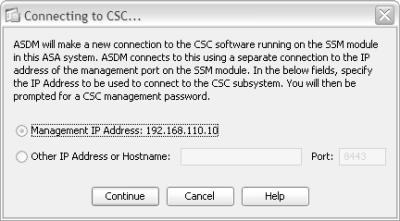
 Figure 12-5: A CSC with Preexisting IP Information
Figure 12-5: A CSC with Preexisting IP Information  Otherwise, the Connecting to CSC... window selects the default IP address that has been configured for the CSC’s management interface. This is fine if your ASDM client can reach the management interface using that address. Suppose the management interface is located on a DMZ interface, but is translated to a different address on the outside of the ASA. In this case, you should select the Other IP Address or Hostname button and enter the translated IP address.
Otherwise, the Connecting to CSC... window selects the default IP address that has been configured for the CSC’s management interface. This is fine if your ASDM client can reach the management interface using that address. Suppose the management interface is located on a DMZ interface, but is translated to a different address on the outside of the ASA. In this case, you should select the Other IP Address or Hostname button and enter the translated IP address. After you are connected to the CSC, you can click on the Wizard Setup link to the left of the window and then on the Launch Setup Wizard button to launch the CSC Setup Wizard.
After you are connected to the CSC, you can click on the Wizard Setup link to the left of the window and then on the Launch Setup Wizard button to launch the CSC Setup Wizard. -
 Enter the CSC activation codes.
Enter the CSC activation codes. A CSC SSM can have the following two license activation codes:
A CSC SSM can have the following two license activation codes:-
 Base license— Enables the Anti-Virus, Anti-Spyware, and File Blocking features
Base license— Enables the Anti-Virus, Anti-Spyware, and File Blocking features -
 Plus license— Enables the Anti-Spam, Anti-Phishing, Content Filtering, and URL Blocking/Filtering features
Plus license— Enables the Anti-Spam, Anti-Phishing, Content Filtering, and URL Blocking/Filtering features
 If your CSC module does not already have valid activation codes entered, you should enter them in the fields shown in Figure 12-4. You can obtain the activation codes by browsing to http://www.cisco.com/go/license and entering the Product Activation Key (PAK) information that was included with the CSC module.
If your CSC module does not already have valid activation codes entered, you should enter them in the fields shown in Figure 12-4. You can obtain the activation codes by browsing to http://www.cisco.com/go/license and entering the Product Activation Key (PAK) information that was included with the CSC module. After the activation codes have been entered into the CSC Setup Wizard, click the Next> button.
After the activation codes have been entered into the CSC Setup Wizard, click the Next> button. -
-
 Enter the IP Configuration.
Enter the IP Configuration. The CSC Setup Wizard should open an IP Configuration window, as shown in Figure 12-6. Enter the CSC management interface IP address, subnet mask, and default gateway. You should also enter the IP addresses of a primary DNS and an optional secondary DNS. If your environment requires outbound connections to pass through a proxy server, you can also enter the IP address and port number of the proxy server.
The CSC Setup Wizard should open an IP Configuration window, as shown in Figure 12-6. Enter the CSC management interface IP address, subnet mask, and default gateway. You should also enter the IP addresses of a primary DNS and an optional secondary DNS. If your environment requires outbound connections to pass through a proxy server, you can also enter the IP address and port number of the proxy server. -
 Enter the CSC Host configuration.
Enter the CSC Host configuration. In the window shown in Figure 12-7, you can enter a hostname and domain name that identifies the CSC SSM management interface. The CSC must also know about the e-mail domain used in your network so that it can examine incoming e-mail.
In the window shown in Figure 12-7, you can enter a hostname and domain name that identifies the CSC SSM management interface. The CSC must also know about the e-mail domain used in your network so that it can examine incoming e-mail.
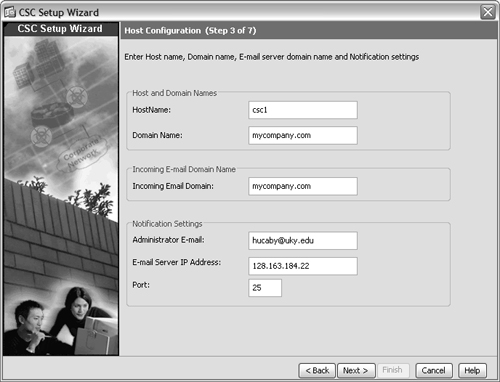
 Figure 12-7: Entering the CSC Host Configuration
Figure 12-7: Entering the CSC Host Configuration  If you want the CSC SSM to send e-mail notifications as it operates, you should enter the e-mail address where those notifications should be sent. The notifications are sent using SMTP, so you should also enter the IP address of your local SMTP server, along with the TCP port used. By default, SMTP uses TCP port 25.
If you want the CSC SSM to send e-mail notifications as it operates, you should enter the e-mail address where those notifications should be sent. The notifications are sent using SMTP, so you should also enter the IP address of your local SMTP server, along with the TCP port used. By default, SMTP uses TCP port 25. After you have entered the IP configuration information, click the Next> button.
After you have entered the IP configuration information, click the Next> button. -
 Configure management access to the CSC.
Configure management access to the CSC. You can limit access to the CSC management interface if your security policies require it. In the window shown in Figure 12-8, you can enter an IP address and a subnet mask that identify hosts that are permitted to access the CSC management interface. This can be a single host or an entire subnet. After you enter the address information, you can click the Add>> button to add it to the list of selected entries. By default, a host at any IP address is allowed to reach the CSC, as shown by the 0.0.0.0/0 entry in the list.
You can limit access to the CSC management interface if your security policies require it. In the window shown in Figure 12-8, you can enter an IP address and a subnet mask that identify hosts that are permitted to access the CSC management interface. This can be a single host or an entire subnet. After you enter the address information, you can click the Add>> button to add it to the list of selected entries. By default, a host at any IP address is allowed to reach the CSC, as shown by the 0.0.0.0/0 entry in the list.
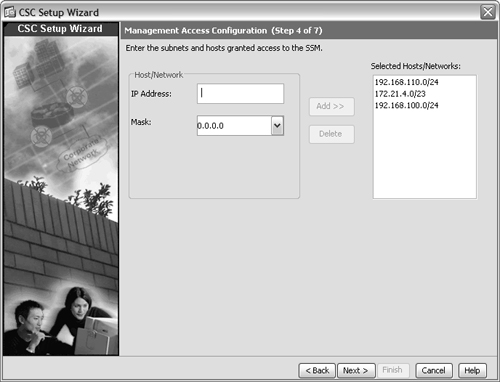
 Figure 12-8: Limiting Access to the CSC Management Interface
Figure 12-8: Limiting Access to the CSC Management Interface  Click the Next> button to continue.
Click the Next> button to continue. -
 Configure the CSC management passwords.
Configure the CSC management passwords. After the initial configuration is completed, you are challenged to enter a password for all future connections to the CSC management interface. By default, the CSC uses password cisco. Because this is commonly known, you should change it now in the window shown in Figure 12-9. However, if you want to leave the password as it is, you can leave the password entries untouched and they will not be changed.
After the initial configuration is completed, you are challenged to enter a password for all future connections to the CSC management interface. By default, the CSC uses password cisco. Because this is commonly known, you should change it now in the window shown in Figure 12-9. However, if you want to leave the password as it is, you can leave the password entries untouched and they will not be changed.
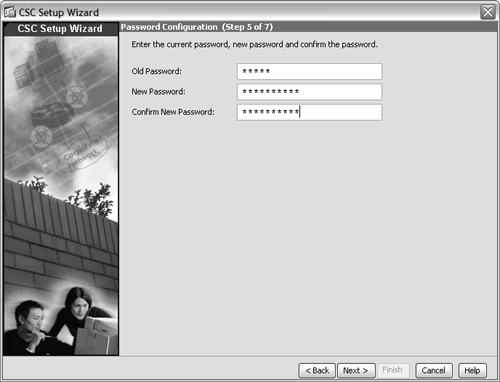
 Figure 12-9: Configuring the CSC Management Password
Figure 12-9: Configuring the CSC Management Password  Click the Next> button to continue.
Click the Next> button to continue. -
 Identify traffic to be inspected.
Identify traffic to be inspected. By default, the CSC inspects HTTP, SMTP, POP3, and FTP traffic between any two hosts. You can configure more specific traffic in the window shown in Figure 12-10. Click the Add button to bring up the Specify Traffic for CSC Scan window, where you can enter source and destination addresses, as well as specific protocol and port numbers.
By default, the CSC inspects HTTP, SMTP, POP3, and FTP traffic between any two hosts. You can configure more specific traffic in the window shown in Figure 12-10. Click the Add button to bring up the Specify Traffic for CSC Scan window, where you can enter source and destination addresses, as well as specific protocol and port numbers. -
 Complete the initial configuration.
Complete the initial configuration. You should see a window showing a summary of each of the initial CSC configuration settings, as shown in Figure 12-11. At this point, ASDM automatically pushes the settings to the CSC, using an out-of-band connection.
You should see a window showing a summary of each of the initial CSC configuration settings, as shown in Figure 12-11. At this point, ASDM automatically pushes the settings to the CSC, using an out-of-band connection.

 Figure 12-11: ASDM Updates the CSC with the Initial Configuration
Figure 12-11: ASDM Updates the CSC with the Initial Configuration
![]() At this point, the CSC management interface has been activated for use. From now on, you are prompted for a password when you try to monitor or configure the CSC.
At this point, the CSC management interface has been activated for use. From now on, you are prompted for a password when you try to monitor or configure the CSC.
 Repairing the Initial CSC Configuration
Repairing the Initial CSC Configuration
![]() If you notice that ASDM is trying to connect to the CSC management interface using an unexpected IP address, you need to repair the initial CSC IP configuration. To do this, first open a CLI-based connection to the ASA, using a console, Telnet, or Secure Shell (SSH) session.
If you notice that ASDM is trying to connect to the CSC management interface using an unexpected IP address, you need to repair the initial CSC IP configuration. To do this, first open a CLI-based connection to the ASA, using a console, Telnet, or Secure Shell (SSH) session.
![]() Then connect to the CSC SSM through the out-of-band connection it shares with the ASA by using the session command.
Then connect to the CSC SSM through the out-of-band connection it shares with the ASA by using the session command.
![]() In the following example, the CSC is installed as module 1 in the ASA chassis. If you are unsure of the CSC’s module number, use the show module ASA command.
In the following example, the CSC is installed as module 1 in the ASA chassis. If you are unsure of the CSC’s module number, use the show module ASA command.
![]() The CSC module prompts for a username and password, rather than a password alone. By default, the username cisco can be used.
The CSC module prompts for a username and password, rather than a password alone. By default, the username cisco can be used.
Firewall# session 1
Opening command session with slot 1.
Connected to slot 1. Escape character sequence is 'CTRL-^X'.
login: cisco
Password:
Last login: Tue Nov 7 10:51:14 from 127.0.1.1
Trend Micro InterScan for Cisco CSC SSM Setup Main Menu
--------------------------------------------------------------
1. Network Settings
2. Date/Time Settings
3. Product Information
4. Service Status
5. Change Password for Command Line Interface
6. Restore Factory Default Settings
7. Troubleshooting Tools
8. Reset Management Port Access Control List
9. Ping
10. Exit ...
Enter a number from [1-10]:
![]() You should use option 1 to change the initial network settings, as shown in the following example output:
You should use option 1 to change the initial network settings, as shown in the following example output:
Enter a number from [1-10]: 1
Network Settings
---------------------------------------------------------------------
IP 10.22.213.113
Netmask 255.255.255.192
Hostname csc
Domain name cisco.com
MAC address 00:18:73:17:8E:B3
Primary DNS 10.10.10.10
Secondary DNS 10.10.10.20
Gateway 10.22.213.65
No Proxy
Do you want to modify the network settings? [y | n]
![]() If you continue with the previous scenario, the CSC management interface should have IP address 192.168.110.10—not 10.22.213.113 shown in the current network settings. Therefore, you should choose y to change the settings. In the following example, all of the initial network settings are changed to their appropriate values.
If you continue with the previous scenario, the CSC management interface should have IP address 192.168.110.10—not 10.22.213.113 shown in the current network settings. Therefore, you should choose y to change the settings. In the following example, all of the initial network settings are changed to their appropriate values.
Do you want to modify the network settings? [y | n] y
Network Settings
---------------------------------------------------------------------
Enter the SSM card IP address: (default:10.22.213.113) 192.168.110.10
Enter subnet mask: (default:255.255.255.192) 255.255.255.0
Enter host name: (default:csc) csc
Enter domain name: (default:cisco.com) mycompany.com
Enter primary DNS IP address: (default:10.10.10.10) 128.163.97.5
Enter optional secondary DNS IP address: (default:10.10.10.20) 128.163.3.10
Enter gateway IP address: (default:10.22.213.65) 192.168.110.1
Do you use a proxy server? [y | n] (default:no)
Stopping services: OK
Applying network settings ...
Starting services: OK
Press Enter to continue ...
![]() After the network settings have been corrected, you can go back to ASDM under the Configuration tab and the Trend Micro Content Security button. At that point, ASDM should open a window showing that it plans to connect to the correct CSC management IP address.
After the network settings have been corrected, you can go back to ASDM under the Configuration tab and the Trend Micro Content Security button. At that point, ASDM should open a window showing that it plans to connect to the correct CSC management IP address.
 Connecting to the CSC Management Interface
Connecting to the CSC Management Interface
![]() After the CSC SSM has received its initial network configuration, you can connect to it through ASDM. When you select the Configuration tab and the Trend Micro Content Security button, ASDM announces that it is getting ready to connect to the CSC, as indicated by the window shown in Figure 12-12.
After the CSC SSM has received its initial network configuration, you can connect to it through ASDM. When you select the Configuration tab and the Trend Micro Content Security button, ASDM announces that it is getting ready to connect to the CSC, as indicated by the window shown in Figure 12-12.
![]() By default, the last known IP address for the CSC management interface is used. In Figure 12-12, this address is 192.168.110.10, which is an address found on the DMZ interface of the ASA. This address can be used if your ASDM host is located on the inside or DMZ interfaces, where the ASA permits connections to that address.
By default, the last known IP address for the CSC management interface is used. In Figure 12-12, this address is 192.168.110.10, which is an address found on the DMZ interface of the ASA. This address can be used if your ASDM host is located on the inside or DMZ interfaces, where the ASA permits connections to that address.
![]() However, if your ASDM host is located elsewhere, such as the outside ASA interface, you need to override the IP address. Select Other IP Address or Hostname and fill in the CSC management interface address as it is known on the outside network. In the example scenario, the ASA is configured to translate DMZ address 192.168.110.10 to outside address 10.1.1.10. Therefore, ASDM should connect to 10.1.1.10 using port 8443.
However, if your ASDM host is located elsewhere, such as the outside ASA interface, you need to override the IP address. Select Other IP Address or Hostname and fill in the CSC management interface address as it is known on the outside network. In the example scenario, the ASA is configured to translate DMZ address 192.168.110.10 to outside address 10.1.1.10. Therefore, ASDM should connect to 10.1.1.10 using port 8443.
![]() After ASDM completes the connection to the CSC management interface, it displays a list of configuration options under Configuration > Trend Micro Content Security. As well, you can view a snapshot of CSC activity by clicking the Home button and selecting the Content Security tab.
After ASDM completes the connection to the CSC management interface, it displays a list of configuration options under Configuration > Trend Micro Content Security. As well, you can view a snapshot of CSC activity by clicking the Home button and selecting the Content Security tab.
 Configuring Automatic Updates
Configuring Automatic Updates
![]() The CSC SSM must be able to retrieve periodic updates from Trend Micro so that it can stay up to date with current spam, spyware, and virus definitions. You should configure the update parameters next.
The CSC SSM must be able to retrieve periodic updates from Trend Micro so that it can stay up to date with current spam, spyware, and virus definitions. You should configure the update parameters next.
![]() From ASDM, select Configuration and then the Trend Micro Content Security button. Log in to the CSC by entering the password at the prompt. In the list of configuration tasks, click on the Updates entry, which shows a summary of the scheduled updates, as shown in Figure 12-13.
From ASDM, select Configuration and then the Trend Micro Content Security button. Log in to the CSC by entering the password at the prompt. In the list of configuration tasks, click on the Updates entry, which shows a summary of the scheduled updates, as shown in Figure 12-13.
![]() Now click on the Configure Updates link under the list of scheduled updates. This opens a new web session with the CSC management interface, using the Trend Micro InterScan for Cisco CSC SSM user interface. Enter the CSC management password at the prompt and click on the Log On button. You should see a browser page like the one shown in Figure 12-14.
Now click on the Configure Updates link under the list of scheduled updates. This opens a new web session with the CSC management interface, using the Trend Micro InterScan for Cisco CSC SSM user interface. Enter the CSC management password at the prompt and click on the Log On button. You should see a browser page like the one shown in Figure 12-14.
![]() In the left-hand list, make sure Scheduled is selected. In the Scheduled Update portion of the window, make sure the Enable Scheduled Update checkbox is checked. Then check each type of update you want to keep updated from the following list:
In the left-hand list, make sure Scheduled is selected. In the Scheduled Update portion of the window, make sure the Enable Scheduled Update checkbox is checked. Then check each type of update you want to keep updated from the following list:
-
 Virus pattern— The database of virus signatures
Virus pattern— The database of virus signatures -
 Virus scan engine— The virus scan software itself
Virus scan engine— The virus scan software itself -
 Spyware pattern— The database of spyware signatures
Spyware pattern— The database of spyware signatures -
 PhishTrap pattern— The database of anti-phishing signatures
PhishTrap pattern— The database of anti-phishing signatures -
 Anti-spam rules and Anti-spam engine— The database of spam detection rules and known spam relays
Anti-spam rules and Anti-spam engine— The database of spam detection rules and known spam relays
![]() Select the update schedule you would like to use, under Update Schedule. By default, updates occur every hour at 14 minutes past the hour. You can select intervals of every 15 minutes, every hour (at a specific minute), or every day (at a specific hour and minute). Click on the Save button to save the update configuration.
Select the update schedule you would like to use, under Update Schedule. By default, updates occur every hour at 14 minutes past the hour. You can select intervals of every 15 minutes, every hour (at a specific minute), or every day (at a specific hour and minute). Click on the Save button to save the update configuration.
![]() If your network environment uses a proxy server to control outbound connections, click on the Proxy Settings link and fill in the settings to define the proxy server address, port, and authentication. Click the Save button to save the proxy settings.
If your network environment uses a proxy server to control outbound connections, click on the Proxy Settings link and fill in the settings to define the proxy server address, port, and authentication. Click the Save button to save the proxy settings.
![]() At this point, you should perform a test to verify that the CSC SSM can indeed get an update from the Trend Micro servers. Most likely, it will not be time for a scheduled update, so you have to force a manual update. In the Trend Micro InterScan for Cisco CSC SSM browser window, click on the Manual link under the Update category. The manual update begins as the CSC checks for the availability of new components from Trend Micro.
At this point, you should perform a test to verify that the CSC SSM can indeed get an update from the Trend Micro servers. Most likely, it will not be time for a scheduled update, so you have to force a manual update. In the Trend Micro InterScan for Cisco CSC SSM browser window, click on the Manual link under the Update category. The manual update begins as the CSC checks for the availability of new components from Trend Micro.
![]() The manual update shows a list of current CSC components along with their version numbers. If newer versions of any of them are found, those are shown in the list with a checkbox and their version numbers in red, as shown in Figure 12-15.
The manual update shows a list of current CSC components along with their version numbers. If newer versions of any of them are found, those are shown in the list with a checkbox and their version numbers in red, as shown in Figure 12-15.
![]() Select each new component by checking their checkboxes and then click the Update button. The update process begins; while this is happening, you should not try to change any other settings on the CSC. If the update is successful, the components are shown in a list again, along with a timestamp when each was updated. The checkboxes are grayed out so that you cannot select them again.
Select each new component by checking their checkboxes and then click the Update button. The update process begins; while this is happening, you should not try to change any other settings on the CSC. If the update is successful, the components are shown in a list again, along with a timestamp when each was updated. The checkboxes are grayed out so that you cannot select them again.
 Configuring CSC Inspection Policies
Configuring CSC Inspection Policies
![]() You can configure the CSC SSM to inspect any of the following types of interesting traffic:
You can configure the CSC SSM to inspect any of the following types of interesting traffic:
-
 Web— Specific URLs and known phishing sites can be blocked, access to websites can be restricted based on a category, file types can be blocked from downloading, and web page content and webmail content can be scanned for undesirable content.
Web— Specific URLs and known phishing sites can be blocked, access to websites can be restricted based on a category, file types can be blocked from downloading, and web page content and webmail content can be scanned for undesirable content. -
 Mail— Incoming and outgoing SMTP traffic, as well as inbound POP3 traffic, can be scanned for undesirable content. Both SMTP and POP3 can be scanned for spam content and can be filtered according to text strings contained in the subject or body, and according to attachment size, filename, and file type.
Mail— Incoming and outgoing SMTP traffic, as well as inbound POP3 traffic, can be scanned for undesirable content. Both SMTP and POP3 can be scanned for spam content and can be filtered according to text strings contained in the subject or body, and according to attachment size, filename, and file type. -
 File Transfer— FTP traffic can be scanned for undesirable content. In addition, files downloaded by FTP can be filtered according to file type.
File Transfer— FTP traffic can be scanned for undesirable content. In addition, files downloaded by FTP can be filtered according to file type.
![]() These categories are shown in ASDM under the Configuration > Trend Micro Content Security screen. When you click on any of the category names, ASDM shows a list of inspection types within that category. However, when you click on an inspection type to configure, ASDM starts up a new browser window using the Trend Micro InterScan for Cisco CSC SSM interface. After the InterScan session begins, you can do all inspection policy configuration from within the same interface without returning to ASDM.
These categories are shown in ASDM under the Configuration > Trend Micro Content Security screen. When you click on any of the category names, ASDM shows a list of inspection types within that category. However, when you click on an inspection type to configure, ASDM starts up a new browser window using the Trend Micro InterScan for Cisco CSC SSM interface. After the InterScan session begins, you can do all inspection policy configuration from within the same interface without returning to ASDM.
![]() In the Trend Micro InterScan for Cisco CSC SSM session, you can use the links listed on the left side of the screen to navigate to various policy configuration screens. These links are used in the sections that follow.
In the Trend Micro InterScan for Cisco CSC SSM session, you can use the links listed on the left side of the screen to navigate to various policy configuration screens. These links are used in the sections that follow.
![]() For HTTP, FTP, or e-mail-based file scanning, the CSC can use its IntelliScan feature to scan files based on a “true file type,” which is determined by header information inside the files, rather than a filename extension. Otherwise, you can specify the filename extensions to be scanned.
For HTTP, FTP, or e-mail-based file scanning, the CSC can use its IntelliScan feature to scan files based on a “true file type,” which is determined by header information inside the files, rather than a filename extension. Otherwise, you can specify the filename extensions to be scanned.
![]() Some files might be password-protected or compressed when they are downloaded. The CSC can attempt to scan these files too. You can choose whether to deliver or delete password-protected files. For compressed files, you can set limits on the extent of the file’s compression process, to protect the CSC resources and the amount of time needed to download, uncompress, and deliver the files. Remember that the CSC has to download the complete file and then uncompress it before it can be delivered to the user.
Some files might be password-protected or compressed when they are downloaded. The CSC can attempt to scan these files too. You can choose whether to deliver or delete password-protected files. For compressed files, you can set limits on the extent of the file’s compression process, to protect the CSC resources and the amount of time needed to download, uncompress, and deliver the files. Remember that the CSC has to download the complete file and then uncompress it before it can be delivered to the user.
![]() By default, password-protected files are delivered. Compressed files are scanned only if they contain less than 200 internal files, are less than 30 MB, require more than three compression passes, or are more than 100 times the size when uncompressed. If the compressed files are not scanned, they are still delivered by default.
By default, password-protected files are delivered. Compressed files are scanned only if they contain less than 200 internal files, are less than 30 MB, require more than three compression passes, or are more than 100 times the size when uncompressed. If the compressed files are not scanned, they are still delivered by default.
![]() You can configure the CSC to scan files only if they are less than a certain size (50 MB by default). If files are too large to be scanned, they are delivered by default.
You can configure the CSC to scan files only if they are less than a certain size (50 MB by default). If files are too large to be scanned, they are delivered by default.
 Configure Web (HTTP) Inspection Policies
Configure Web (HTTP) Inspection Policies
![]() If you plan to have the CSC SSM inspect web traffic for suspicious or unwanted content, you should configure the inspection policies discussed in the following sections.
If you plan to have the CSC SSM inspect web traffic for suspicious or unwanted content, you should configure the inspection policies discussed in the following sections.
Configuring URL Blocking
![]() By default, the CSC SSM does not block any URLs that internal users attempt to view. You can configure a local list of strings to match against by selecting the Via Local List tab, as shown in Figure 12-16.
By default, the CSC SSM does not block any URLs that internal users attempt to view. You can configure a local list of strings to match against by selecting the Via Local List tab, as shown in Figure 12-16.
![]() Under Web (HTTP) > URL Blocking, you can enter specific URLs in the Match: field. Click the Block button to add the URL to the block list or the Do Not Block button to permit the URL to be reached. URLs can be matched as specific website address prefixes, keyword matching, or specific hostname/file string matching. Click the Save button to save your changes.
Under Web (HTTP) > URL Blocking, you can enter specific URLs in the Match: field. Click the Block button to add the URL to the block list or the Do Not Block button to permit the URL to be reached. URLs can be matched as specific website address prefixes, keyword matching, or specific hostname/file string matching. Click the Save button to save your changes.
![]() The CSC SSM can also scan URLs to detect phishing sites, spyware sites, virus accomplice sites, and other sites that are known to have malicious purposes. From the Web (HTTP) > URL Blocking page, click on the Via Pattern File (PhishTrap) tab to see the window shown in Figure 12-17. By default, the CSC blocks users from reaching URLs that are known to have any of the listed types of activities. The database of URLs is maintained by Trend Micro and is automatically downloaded to the CSC during the scheduled updates. If you make any changes to the configuration, be sure to click the Save button.
The CSC SSM can also scan URLs to detect phishing sites, spyware sites, virus accomplice sites, and other sites that are known to have malicious purposes. From the Web (HTTP) > URL Blocking page, click on the Via Pattern File (PhishTrap) tab to see the window shown in Figure 12-17. By default, the CSC blocks users from reaching URLs that are known to have any of the listed types of activities. The database of URLs is maintained by Trend Micro and is automatically downloaded to the CSC during the scheduled updates. If you make any changes to the configuration, be sure to click the Save button.
![]() If you discover a website that seems to promote any of the Phish Trap categories is not blocked by the CSC, you can submit the URL to Trend Micro by filling in the URL and category in the bottom portion of the window. Add any notes that describe the website and its behavior to the Note: section and then click on the Submit button. The information you provide is automatically sent to Trend Micro for their analysis.
If you discover a website that seems to promote any of the Phish Trap categories is not blocked by the CSC, you can submit the URL to Trend Micro by filling in the URL and category in the bottom portion of the window. Add any notes that describe the website and its behavior to the Note: section and then click on the Submit button. The information you provide is automatically sent to Trend Micro for their analysis.
![]() Finally, you should click on the Notification tab to review the action that the CSC takes when it blocks a user from reaching a URL. By default, the CSC returns the following message in the user’s browser:
Finally, you should click on the Notification tab to review the action that the CSC takes when it blocks a user from reaching a URL. By default, the CSC returns the following message in the user’s browser:
The URL you are attempting to access has been blocked. Organization policy does not allow
access to this activity.
![]() You can change that text by editing the User Notification field and clicking the Save button.
You can change that text by editing the User Notification field and clicking the Save button.
Configuring URL Filtering Rules
![]() If your corporate policies warrant, you might want to control what web content your users can browse at different times of the day. The CSC SSM can use its URL Filtering feature to accomplish this automatically. Trend Micro maintains a database of URLs that are broken down into content categories. The CSC downloads this database during scheduled updates and can use it to categorize URLs as they are browsed.
If your corporate policies warrant, you might want to control what web content your users can browse at different times of the day. The CSC SSM can use its URL Filtering feature to accomplish this automatically. Trend Micro maintains a database of URLs that are broken down into content categories. The CSC downloads this database during scheduled updates and can use it to categorize URLs as they are browsed.
![]() First, you must define some policies that the CSC can use to make decisions about whether a URL category is appropriate at any given time. Under the Web (HTTP) > URL Filtering section, go to the Filtering Rules link, as shown in Figure 12-18. Here, you can select whether to block any of the following categories during work time or leisure time (not work time).
First, you must define some policies that the CSC can use to make decisions about whether a URL category is appropriate at any given time. Under the Web (HTTP) > URL Filtering section, go to the Filtering Rules link, as shown in Figure 12-18. Here, you can select whether to block any of the following categories during work time or leisure time (not work time).
-
 Company prohibited sites
Company prohibited sites -
 Not work related
Not work related -
 Research topics
Research topics -
 Business function related
Business function related -
 Customer defined
Customer defined -
 Others
Others
![]() Clearly, these categories are rather broad and subjective. You define or tune the categories to meet your own needs as a second step. For now, you can make some broad assumptions based on the general category names. For example, Figure 12-18 shows how Company prohibited sites are blocked during work time and leisure time. That might make sense if your company policies state that users should do only work-related activities while they are at work or are using work-related equipment.
Clearly, these categories are rather broad and subjective. You define or tune the categories to meet your own needs as a second step. For now, you can make some broad assumptions based on the general category names. For example, Figure 12-18 shows how Company prohibited sites are blocked during work time and leisure time. That might make sense if your company policies state that users should do only work-related activities while they are at work or are using work-related equipment.
Configuring URL Filtering Settings
![]() Next, you can begin to fine tune the URL categories to match your preferences or security policies. Under Web (HTTP) > URL Filtering, select the Settings link. This brings up a new window, as shown in Figure 12-19, with the following configuration tabs:
Next, you can begin to fine tune the URL categories to match your preferences or security policies. Under Web (HTTP) > URL Filtering, select the Settings link. This brings up a new window, as shown in Figure 12-19, with the following configuration tabs:
-
 URL Categories— Group specific web content sub-categories into the broad URL categories
URL Categories— Group specific web content sub-categories into the broad URL categories -
 URL Filtering Exceptions— Match against URLs that are excluded from filtering
URL Filtering Exceptions— Match against URLs that are excluded from filtering -
 Schedule— Define specific day and time ranges that are considered as “work time”
Schedule— Define specific day and time ranges that are considered as “work time” -
 Re-classify URL— Submit a URL to Trend Micro to request it be reclassified in a different category
Re-classify URL— Submit a URL to Trend Micro to request it be reclassified in a different category
![]() Use the following steps to configure URL filtering:
Use the following steps to configure URL filtering:
-
 Define URL categories.
Define URL categories. Trend Micro has defined a list of narrow “sub-categories” that describe web content that is available on the Internet. URLs are then mapped to sub-categories based on the content they contain. For example, if a URL presents a page showing people wearing intimate apparel or swimsuits, it might be tagged as belonging to the Intimate Apparel/Swimsuit sub-category.
Trend Micro has defined a list of narrow “sub-categories” that describe web content that is available on the Internet. URLs are then mapped to sub-categories based on the content they contain. For example, if a URL presents a page showing people wearing intimate apparel or swimsuits, it might be tagged as belonging to the Intimate Apparel/Swimsuit sub-category. In turn, the CSC can map sub-categories into the broad URL categories that have URL filtering policies applied to them. The list of sub-categories and how they are mapped are shown in Figure 12-19.
In turn, the CSC can map sub-categories into the broad URL categories that have URL filtering policies applied to them. The list of sub-categories and how they are mapped are shown in Figure 12-19. By default, sub-categories like Illegal Drugs and Violence/Hate/Racism are mapped into the Company Prohibited Sites category, Gambling is mapped to Non-work Related, and Weapons into the Other category. You can change any of these mappings by selecting the checkboxes of sub-categories you want to move and then choosing a new category from the Move Selected Sub-categories to: drop-down list. Finally, you click on the Move button.
By default, sub-categories like Illegal Drugs and Violence/Hate/Racism are mapped into the Company Prohibited Sites category, Gambling is mapped to Non-work Related, and Weapons into the Other category. You can change any of these mappings by selecting the checkboxes of sub-categories you want to move and then choosing a new category from the Move Selected Sub-categories to: drop-down list. Finally, you click on the Move button. Remember that the sub-categories are mapped into categories, and the categories are enforced during work time and/or leisure time, according to the policies you define.
Remember that the sub-categories are mapped into categories, and the categories are enforced during work time and/or leisure time, according to the policies you define. -
 Identify any URL exceptions.
Identify any URL exceptions. If there are websites that should be exempt from URL filtering and should always be available to your users, you can specify them as filtering exceptions. Select the URL Filtering Exceptions tab under Web (HTTP) > URL Filtering > Settings, as shown in Figure 12-20. You can enter a specific URL as a website, or you can enter a keyword or a text string to match against. Be sure to click the Add button to add your entry to the list of exceptions. Finally, click the Save button to save the changes.
If there are websites that should be exempt from URL filtering and should always be available to your users, you can specify them as filtering exceptions. Select the URL Filtering Exceptions tab under Web (HTTP) > URL Filtering > Settings, as shown in Figure 12-20. You can enter a specific URL as a website, or you can enter a keyword or a text string to match against. Be sure to click the Add button to add your entry to the list of exceptions. Finally, click the Save button to save the changes.
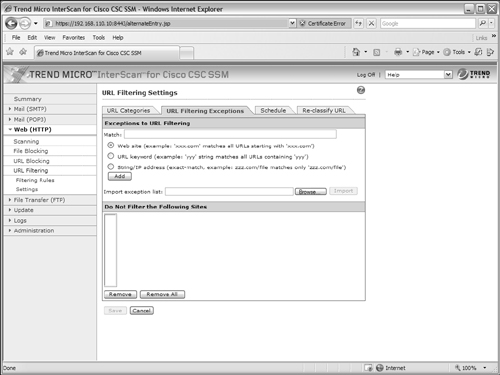
 Figure 12-20: Defining URLs That Are Exceptions to URL Filtering
Figure 12-20: Defining URLs That Are Exceptions to URL Filtering -
 The CSC performs URL filtering based on a time schedule. All time is divided into “work time” and “leisure time” (not work time). Therefore, you should configure the CSC to have the correct concept of work time. Select the Schedule tab under Web (HTTP) > URL Filtering > Settings, as shown in Figure 12-21. By default, work time is defined as Monday through Friday, from 08:00 until 12:00, and then from 13:00 until 17:00. To change this, select the checkboxes for any days that contain work time. Then select morning and afternoon start and end times from the drop-down time menus. Be sure to click the Save button when you are finished making changes.
The CSC performs URL filtering based on a time schedule. All time is divided into “work time” and “leisure time” (not work time). Therefore, you should configure the CSC to have the correct concept of work time. Select the Schedule tab under Web (HTTP) > URL Filtering > Settings, as shown in Figure 12-21. By default, work time is defined as Monday through Friday, from 08:00 until 12:00, and then from 13:00 until 17:00. To change this, select the checkboxes for any days that contain work time. Then select morning and afternoon start and end times from the drop-down time menus. Be sure to click the Save button when you are finished making changes. -
 Submit a URL for reclassification.
Submit a URL for reclassification. If you find that a URL’s content does not agree with the Trend Micro content category, you can submit the URL to Trend Micro for reclassification. If they agree, they put the URL into the category you suggest. To do this, select the Re-classify URL tab under Web (HTTP) > URL Filtering > Settings, as shown in Figure 12-22. Enter the URL, your e-mail address, and some notes to justify the category where you think the URL should belong. Click the Submit button when you are ready for the CSC to e-mail your request to Trend Micro.
If you find that a URL’s content does not agree with the Trend Micro content category, you can submit the URL to Trend Micro for reclassification. If they agree, they put the URL into the category you suggest. To do this, select the Re-classify URL tab under Web (HTTP) > URL Filtering > Settings, as shown in Figure 12-22. Enter the URL, your e-mail address, and some notes to justify the category where you think the URL should belong. Click the Submit button when you are ready for the CSC to e-mail your request to Trend Micro.
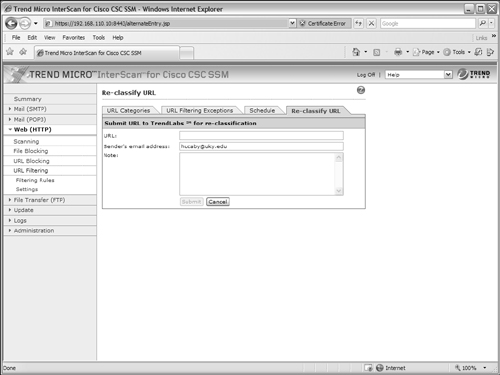
 Figure 12-22: Requesting That a URL Be Reclassified in a Different Category
Figure 12-22: Requesting That a URL Be Reclassified in a Different Category
Configuring HTTP File Blocking
![]() As users browse to websites, the CSC can block specific file types from being downloaded. To do this, select the Target tab under Web (HTTP) > File Blocking, as shown in Figure 12-23. Select the files types you want to be blocked from the list of audio/video, compressed, executable, images, Java, and Microsoft Office. You can also specify additional file extensions to be blocked by entering them in the File extensions to block: field and clicking the Add button. After all of your changes have been made, be sure to click the Save button.
As users browse to websites, the CSC can block specific file types from being downloaded. To do this, select the Target tab under Web (HTTP) > File Blocking, as shown in Figure 12-23. Select the files types you want to be blocked from the list of audio/video, compressed, executable, images, Java, and Microsoft Office. You can also specify additional file extensions to be blocked by entering them in the File extensions to block: field and clicking the Add button. After all of your changes have been made, be sure to click the Save button.
Configuring HTTP Scanning
![]() The CSC can scan files as they are downloaded as part of a web page or HTTP content. HTTP scanning can be done on all HTTP traffic (the default) or on webmail traffic only. To configure HTTP scanning, select the Target tab under the Web (HTTP) > Scanning link, as shown in Figure 12-24.
The CSC can scan files as they are downloaded as part of a web page or HTTP content. HTTP scanning can be done on all HTTP traffic (the default) or on webmail traffic only. To configure HTTP scanning, select the Target tab under the Web (HTTP) > Scanning link, as shown in Figure 12-24.
![]() You can use the following sequence of steps to configure HTTP scanning on a CSC SSM:
You can use the following sequence of steps to configure HTTP scanning on a CSC SSM:
-
 Configure file scanning.
Configure file scanning. First, choose the default type of file scanning. By default, the CSC scans all files as they are downloaded as part of a web page content.
First, choose the default type of file scanning. By default, the CSC scans all files as they are downloaded as part of a web page content. You can also specify individual types of spyware and grayware content to be detected during HTTP file scanning. By default, none of these types are detected. Be sure to click the Save button when you are finished configuring the Target tab.
You can also specify individual types of spyware and grayware content to be detected during HTTP file scanning. By default, none of these types are detected. Be sure to click the Save button when you are finished configuring the Target tab. -
 Configure webmail scanning.
Configure webmail scanning. To configure the CSC to scan webmail content, select the Webmail Scanning tab under the Web (HTTP) > Scanning link, as shown in Figure 12-25.
To configure the CSC to scan webmail content, select the Webmail Scanning tab under the Web (HTTP) > Scanning link, as shown in Figure 12-25.
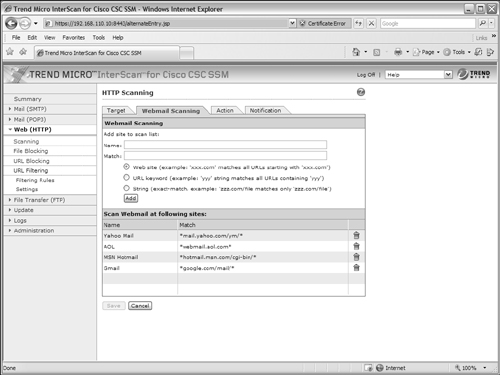
 Figure 12-25: Configuring Webmail Scanning
Figure 12-25: Configuring Webmail Scanning  By default, the CSC scans webmail content when users go to the Yahoo! Mail, AOL, MSN Hotmail, or Gmail sites using the URL patterns shown in Figure 12-25. You can add other specific URLs or keywords and text strings to match if your users go to webmail sites other than those listed. Enter a descriptive name in the Name field and a URL or match string in the Match field. Click the Add button to add the entries to the webmail scan list. Be sure to click the Save button after you are finished with the configuration.
By default, the CSC scans webmail content when users go to the Yahoo! Mail, AOL, MSN Hotmail, or Gmail sites using the URL patterns shown in Figure 12-25. You can add other specific URLs or keywords and text strings to match if your users go to webmail sites other than those listed. Enter a descriptive name in the Name field and a URL or match string in the Match field. Click the Add button to add the entries to the webmail scan list. Be sure to click the Save button after you are finished with the configuration. -
 By default, the CSC attempts to clean files that it finds infected with a virus or malware. If a file cannot be cleaned, it is deleted from the HTTP content. Any spyware or grayware is deleted rather than delivered. You can change these policies by selecting the Action tab under the Web (HTTP) > Scanning link.
By default, the CSC attempts to clean files that it finds infected with a virus or malware. If a file cannot be cleaned, it is deleted from the HTTP content. Any spyware or grayware is deleted rather than delivered. You can change these policies by selecting the Action tab under the Web (HTTP) > Scanning link. -
 Define the notification.
Define the notification. When the CSC detects an infected file that it also deletes, it posts the following message to the user’s browser:
When the CSC detects an infected file that it also deletes, it posts the following message to the user’s browser: The InterScan for CSC SSM has scanned the file you are attempting to transfer, and
The InterScan for CSC SSM has scanned the file you are attempting to transfer, and
has detected a security risk - the file will not be transferred. You can change that message by editing the text under the Notification tab.
You can change that message by editing the text under the Notification tab.
 Configuring File Transfer (FTP) Inspection Policies
Configuring File Transfer (FTP) Inspection Policies
![]() If you plan to have the CSC SSM inspect FTP traffic for suspicious or unwanted content, you should configure the inspection policies discussed in the following steps.
If you plan to have the CSC SSM inspect FTP traffic for suspicious or unwanted content, you should configure the inspection policies discussed in the following steps.
-
 Configure inspection policies for file scanning.
Configure inspection policies for file scanning. The CSC can scan files to detect undesirable content as the files are downloaded by FTP. This process and its configuration are very similar to HTTP scanning. To configure FTP file scanning, select the Target tab under the File Transfer (FTP) > Scanning link, as shown in Figure 12-26.
The CSC can scan files to detect undesirable content as the files are downloaded by FTP. This process and its configuration are very similar to HTTP scanning. To configure FTP file scanning, select the Target tab under the File Transfer (FTP) > Scanning link, as shown in Figure 12-26.
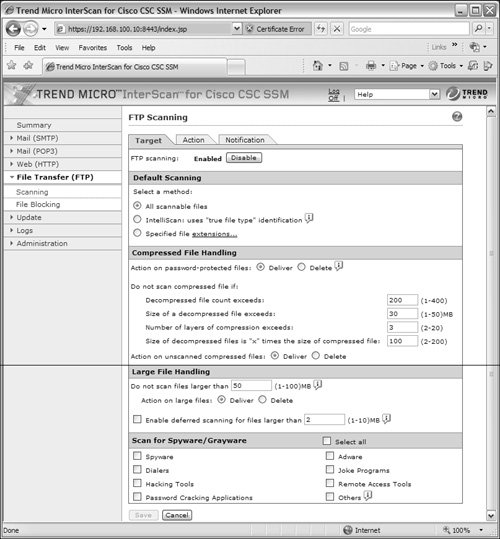
 Figure 12-26: Configuring FTP File Scanning
Figure 12-26: Configuring FTP File Scanning  First, choose the default type of file scanning. By default, the CSC scans all files as they are downloaded through an FTP connection.
First, choose the default type of file scanning. By default, the CSC scans all files as they are downloaded through an FTP connection. You can also specify individual types of spyware and grayware content that is detected during FTP file scanning. By default, none of these types are detected. Be sure to click the Save button when you are finished configuring the Target tab.
You can also specify individual types of spyware and grayware content that is detected during FTP file scanning. By default, none of these types are detected. Be sure to click the Save button when you are finished configuring the Target tab. By default, the CSC attempts to clean files that it finds infected with a virus or malware. If a file cannot be cleaned, it is deleted and not delivered to the end user. Any spyware or grayware is deleted rather than delivered. You can change these policies by selecting the Action tab under the File Transfer (FTP) > Scanning link.
By default, the CSC attempts to clean files that it finds infected with a virus or malware. If a file cannot be cleaned, it is deleted and not delivered to the end user. Any spyware or grayware is deleted rather than delivered. You can change these policies by selecting the Action tab under the File Transfer (FTP) > Scanning link. When the CSC detects an infected file that it also deletes, it posts the following message to the user’s browser:
When the CSC detects an infected file that it also deletes, it posts the following message to the user’s browser: The InterScan for CSC SSM has scanned the file you are attempting to transfer, and
The InterScan for CSC SSM has scanned the file you are attempting to transfer, and
has detected a security risk - the file will not be transferred. You can change that message by editing the text under the Notification tab.
You can change that message by editing the text under the Notification tab. -
 Configure inspection policies for FTP file blocking.
Configure inspection policies for FTP file blocking. As users attempt to download files by FTP, the CSC can block specific file types from being downloaded. To do this, select the Target tab under File Transfer (FTP) > File Blocking, as shown in Figure 12-27.
As users attempt to download files by FTP, the CSC can block specific file types from being downloaded. To do this, select the Target tab under File Transfer (FTP) > File Blocking, as shown in Figure 12-27.
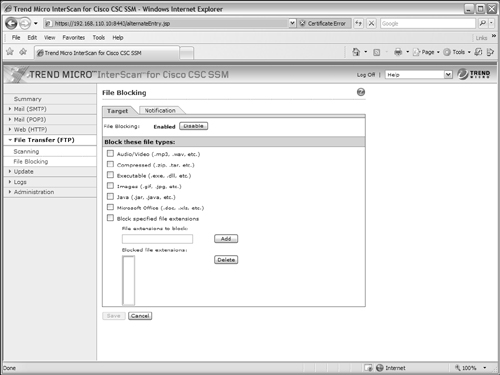
 Figure 12-27: Specifying File Types to Block in FTP Content
Figure 12-27: Specifying File Types to Block in FTP Content  Select the files types you want to be blocked from the list of audio/video, compressed, executable, images, Java, and Microsoft Office. You can also specify additional file extensions to be blocked by entering them in the File extensions to block: field and clicking the Add button. After all of your changes have been made, be sure to click the Save button.
Select the files types you want to be blocked from the list of audio/video, compressed, executable, images, Java, and Microsoft Office. You can also specify additional file extensions to be blocked by entering them in the File extensions to block: field and clicking the Add button. After all of your changes have been made, be sure to click the Save button.
 Configuring Mail (SMTP and POP3) Inspection Policies
Configuring Mail (SMTP and POP3) Inspection Policies
![]() If you plan to have the CSC SSM inspect e-mail traffic for suspicious or unwanted content, you should configure the inspection policies discussed in the sections that follow. The CSC can scan inbound traffic destined for SMTP servers, outbound traffic destined for SMTP servers, and inbound POP3 traffic destined for clients.
If you plan to have the CSC SSM inspect e-mail traffic for suspicious or unwanted content, you should configure the inspection policies discussed in the sections that follow. The CSC can scan inbound traffic destined for SMTP servers, outbound traffic destined for SMTP servers, and inbound POP3 traffic destined for clients.
![]() Also, the CSC can filter the content of e-mail messages, based on the file type and content of attachments. You can also configure the CSC to scan for spam e-mail and take action on offending messages.
Also, the CSC can filter the content of e-mail messages, based on the file type and content of attachments. You can also configure the CSC to scan for spam e-mail and take action on offending messages.
Scanning SMTP Traffic
![]() The CSC can scan SMTP messages to detect undesirable or malicious content. You can configure SMTP scanning by going to Mail (SMTP) > Scanning and then selecting either the Incoming or Outgoing link, depending on the direction that SMTP traffic is traveling in your network. If you have an SMTP server on the inside or DMZ interface of the ASA, configure incoming scanning to watch traffic coming in from external clients. Configure outgoing scanning to watch traffic being sent by internal clients:
The CSC can scan SMTP messages to detect undesirable or malicious content. You can configure SMTP scanning by going to Mail (SMTP) > Scanning and then selecting either the Incoming or Outgoing link, depending on the direction that SMTP traffic is traveling in your network. If you have an SMTP server on the inside or DMZ interface of the ASA, configure incoming scanning to watch traffic coming in from external clients. Configure outgoing scanning to watch traffic being sent by internal clients:
-
 Configure the scanning target.
Configure the scanning target. Select the Target tab, as shown in Figure 12-28. First, choose the default type of file scanning. By default, the CSC scans all attachment files as they are sent through an SMTP connection.
Select the Target tab, as shown in Figure 12-28. First, choose the default type of file scanning. By default, the CSC scans all attachment files as they are sent through an SMTP connection.
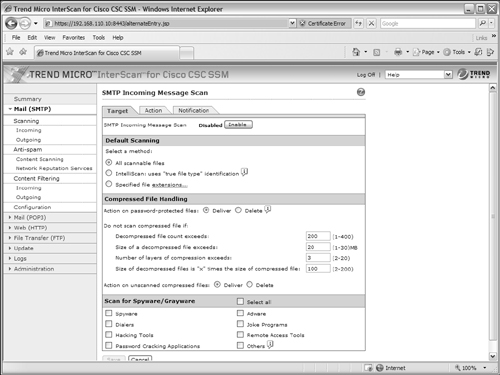
 Figure 12-28: Configuring SMTP Message Scanning
Figure 12-28: Configuring SMTP Message Scanning  You can also specify individual types of spyware and grayware content to be detected during FTP file scanning. By default, none of these types are detected. Be sure to click the Save button when you are finished configuring the Target tab.
You can also specify individual types of spyware and grayware content to be detected during FTP file scanning. By default, none of these types are detected. Be sure to click the Save button when you are finished configuring the Target tab. -
 Configure the action.
Configure the action. Select the Action tab. If an attachment is found to have a virus or malware, it can be cleaned (the default). As an alternative, the CSC can deliver the message after the offending attachment has been deleted, or it can deliver the original message intact—offending attachment and all.
Select the Action tab. If an attachment is found to have a virus or malware, it can be cleaned (the default). As an alternative, the CSC can deliver the message after the offending attachment has been deleted, or it can deliver the original message intact—offending attachment and all. With spyware and grayware, you can configure the CSC to deliver the offending files or delete them (the default).
With spyware and grayware, you can configure the CSC to deliver the offending files or delete them (the default). -
 Configure the notification.
Configure the notification. When the CSC detects suspicious content in an e-mail attachment file, it can send a notification. To configure this feature, select the Notification tab as shown in Figure 12-29. By default, no notifications are sent by e-mail. However, you can choose whether to send e-mail notices to the CSC administrator (the e-mail address you configured for CSC notifications), the e-mail message sender, and the e-mail message recipient.
When the CSC detects suspicious content in an e-mail attachment file, it can send a notification. To configure this feature, select the Notification tab as shown in Figure 12-29. By default, no notifications are sent by e-mail. However, you can choose whether to send e-mail notices to the CSC administrator (the e-mail address you configured for CSC notifications), the e-mail message sender, and the e-mail message recipient.

 Figure 12-29: Configuring SMTP Message Scanning Notification
Figure 12-29: Configuring SMTP Message Scanning Notification  By default, the CSC notifies the e-mail message recipient by inserting a descriptive message into the e-mail message text. You can also configure the CSC to insert a “risk free” message into the text of every message that has clean scanning results.
By default, the CSC notifies the e-mail message recipient by inserting a descriptive message into the e-mail message text. You can also configure the CSC to insert a “risk free” message into the text of every message that has clean scanning results.
Filtering SMTP Content
![]() You can configure the CSC to filter incoming or outgoing SMTP messages according to specific things that are found in the message itself. Under Mail (SMTP) > Content Filtering, choose the Incoming or Outgoing link (as shown in Figure 12-30), depending on the direction the target e-mail will be traveling in relation to the ASA.
You can configure the CSC to filter incoming or outgoing SMTP messages according to specific things that are found in the message itself. Under Mail (SMTP) > Content Filtering, choose the Incoming or Outgoing link (as shown in Figure 12-30), depending on the direction the target e-mail will be traveling in relation to the ASA.
![]() You can configure the CSC to filter out messages that are larger or smaller than a given size. This can be handy to filter out messages that contain very large attachments. The CSC can also filter messages if it finds specific words in the subject line or the message body text. To accomplish this, enter the words in the Add words to subject filter field or Add words to body filter field and click on the Add button.
You can configure the CSC to filter out messages that are larger or smaller than a given size. This can be handy to filter out messages that contain very large attachments. The CSC can also filter messages if it finds specific words in the subject line or the message body text. To accomplish this, enter the words in the Add words to subject filter field or Add words to body filter field and click on the Add button.
![]() You can also configure the CSC to filter messages according to the attributes of attachments. For example, you can enter specific words or character strings to match against the attachment filenames. You can also select attachment file types to filter out.
You can also configure the CSC to filter messages according to the attributes of attachments. For example, you can enter specific words or character strings to match against the attachment filenames. You can also select attachment file types to filter out.
![]() Under the Action tab, you can choose whether to delete or deliver (the default) messages that are filtered. You can also select a text message to insert in the mail message to alert the user of the filtered condition. Finally, the Notification tab allows an alert to be sent to the CSC administrator, the message sender, or the message recipient when a message has been filtered.
Under the Action tab, you can choose whether to delete or deliver (the default) messages that are filtered. You can also select a text message to insert in the mail message to alert the user of the filtered condition. Finally, the Notification tab allows an alert to be sent to the CSC administrator, the message sender, or the message recipient when a message has been filtered.
Detecting Spam SMTP E-mail
![]() The CSC can detect spam e-mail by comparing information found in the message headers with a database maintained by Trend Micro. Anti-spam operation is independent of traffic direction—the CSC simply examines all e-mail messages as they pass through it.
The CSC can detect spam e-mail by comparing information found in the message headers with a database maintained by Trend Micro. Anti-spam operation is independent of traffic direction—the CSC simply examines all e-mail messages as they pass through it.
![]() You can configure the following types of anti-spam detection:
You can configure the following types of anti-spam detection:
-
 Content scanning— E-mail messages are examined as they are sent and are compared to a database of known spam patterns maintained by Trend Micro.
Content scanning— E-mail messages are examined as they are sent and are compared to a database of known spam patterns maintained by Trend Micro. -
 Network reputation services— E-mail senders are examined and compared to a database of IP addresses known to produce spam. The sender’s reputation of being a source of spam is used as the metric for spam detection. This makes identifying spam relays and known spam sources relatively easy and fast.
Network reputation services— E-mail senders are examined and compared to a database of IP addresses known to produce spam. The sender’s reputation of being a source of spam is used as the metric for spam detection. This makes identifying spam relays and known spam sources relatively easy and fast.
![]() You can use the following steps to configure SMTP anti-spam operation.
You can use the following steps to configure SMTP anti-spam operation.
-
 Configure SMTP content scanning.
Configure SMTP content scanning. Under the Mail (SMTP) > Anti-spam > Content Scanning link, select the Target tab, as shown in Figure 12-31. You can set the level of anti-spam detection in the Filter Threshold section. By default, the CSC uses a Low setting. The higher the setting, the more likely spam messages are detected. Also, you have a greater chance that the CSC triggers on false positives, or legitimate e-mail messages that it mistakenly labels as spam. If you find that a reasonable number of spam messages are getting through without detection, you can increase the filter threshold.
Under the Mail (SMTP) > Anti-spam > Content Scanning link, select the Target tab, as shown in Figure 12-31. You can set the level of anti-spam detection in the Filter Threshold section. By default, the CSC uses a Low setting. The higher the setting, the more likely spam messages are detected. Also, you have a greater chance that the CSC triggers on false positives, or legitimate e-mail messages that it mistakenly labels as spam. If you find that a reasonable number of spam messages are getting through without detection, you can increase the filter threshold.

 Figure 12-31: Configuring SMTP Anti-Spam Content Scanning
Figure 12-31: Configuring SMTP Anti-Spam Content Scanning  You can also add specific e-mail addresses or domain names to a list of approved senders or blocked senders. If the sender’s address is found in the list of approved senders, the message is delivered without anti-spam detection. If the address is found in the list of blocked senders, all messages from that sender are dropped without delivery.
You can also add specific e-mail addresses or domain names to a list of approved senders or blocked senders. If the sender’s address is found in the list of approved senders, the message is delivered without anti-spam detection. If the address is found in the list of blocked senders, all messages from that sender are dropped without delivery. Under the Action tab, you can configure the action the CSC takes if it detects a spam message. By default, the message is “stamped” by having the text string Spam: added to the subject line. Stamping messages makes it easier for end users to create e-mail filters that can recognize the stamp string and take action automatically. Otherwise, you can configure the CSC to automatically delete spam messages before delivering them.
Under the Action tab, you can configure the action the CSC takes if it detects a spam message. By default, the message is “stamped” by having the text string Spam: added to the subject line. Stamping messages makes it easier for end users to create e-mail filters that can recognize the stamp string and take action automatically. Otherwise, you can configure the CSC to automatically delete spam messages before delivering them. -
 Configure Network Reputation Services.
Configure Network Reputation Services. By default, SMTP anti-spam Network Reputation Services are enabled. The CSC can make use of the following two types of anti-spam services from Trend Micro:
By default, SMTP anti-spam Network Reputation Services are enabled. The CSC can make use of the following two types of anti-spam services from Trend Micro:-
 Real-Time Blackhole List (RBL+)— Spam senders are identified by IP address from a list of known spam originators. This database is accurate and stable, but is not updated at the CSC in real time.
Real-Time Blackhole List (RBL+)— Spam senders are identified by IP address from a list of known spam originators. This database is accurate and stable, but is not updated at the CSC in real time. -
 Quick IP List (QIL)— Spam senders are identified using a dynamic exchange between the CSC and Trend Micro. New spam originators can be identified in real time because the CSC is constantly comparing sender addresses with the QIL content from Trend Micro. This database offers the most timely detection of new spam senders, but requires interactive communication with the Trend Micro servers.
Quick IP List (QIL)— Spam senders are identified using a dynamic exchange between the CSC and Trend Micro. New spam originators can be identified in real time because the CSC is constantly comparing sender addresses with the QIL content from Trend Micro. This database offers the most timely detection of new spam senders, but requires interactive communication with the Trend Micro servers.
 You can set the level of anti-spam detection by going to the Mail (SMTP) > Anti-spam > Network Reputation Services link and selecting the Target tab, as shown in Figure 12-32. Under the Set Service Level section, you can choose High or Low. A setting of High uses the complete Trend Micro Network Anti-spam Service, which can identify known or likely spam senders by IP address, previous spam reputation, or current suspicious activity. A setting of Low uses a more basic Trend Micro database of known spam senders.
You can set the level of anti-spam detection by going to the Mail (SMTP) > Anti-spam > Network Reputation Services link and selecting the Target tab, as shown in Figure 12-32. Under the Set Service Level section, you can choose High or Low. A setting of High uses the complete Trend Micro Network Anti-spam Service, which can identify known or likely spam senders by IP address, previous spam reputation, or current suspicious activity. A setting of Low uses a more basic Trend Micro database of known spam senders.
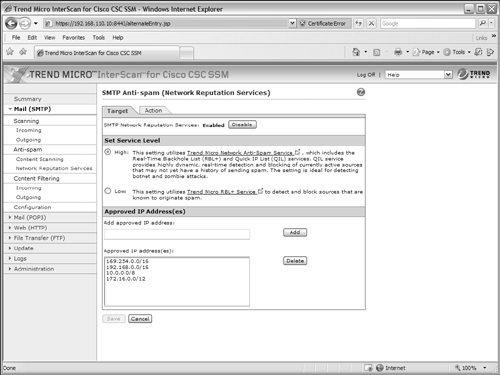
 Figure 12-32: Configuring SMTP Anti-Spam Network Reputation Services
Figure 12-32: Configuring SMTP Anti-Spam Network Reputation Services  In the Approved IP Address(es) section, the CSC also keeps a list of addresses and subnets that it considers to be trusted or approved senders. Users sending SMTP messages from these addresses are approved to do so. By default, the following addresses are added to the approved list:
In the Approved IP Address(es) section, the CSC also keeps a list of addresses and subnets that it considers to be trusted or approved senders. Users sending SMTP messages from these addresses are approved to do so. By default, the following addresses are added to the approved list: Notice that each of these subnets represents private address space as defined in RFC 1918. These addresses are not routable over the Internet and should be found only on an inside or protected interface of the ASA. In other words, the CSC considers your own internal users to have a good reputation in sending spam-free e-mail.
Notice that each of these subnets represents private address space as defined in RFC 1918. These addresses are not routable over the Internet and should be found only on an inside or protected interface of the ASA. In other words, the CSC considers your own internal users to have a good reputation in sending spam-free e-mail. Under the Action tab, you can configure the action to take when e-mail senders are matched as spam senders. The actions are grouped according to the type of anti-spam detection: RBL+ or QIL match. By default, each type of match leads to Intelligent action, where the CSC denies the spam sender’s SMTP connection and sends an SMTP error code. You can also choose to close the SMTP connection with no error code or to simply log the detection and deliver the spam message.
Under the Action tab, you can configure the action to take when e-mail senders are matched as spam senders. The actions are grouped according to the type of anti-spam detection: RBL+ or QIL match. By default, each type of match leads to Intelligent action, where the CSC denies the spam sender’s SMTP connection and sends an SMTP error code. You can also choose to close the SMTP connection with no error code or to simply log the detection and deliver the spam message. -
Configuring General SMTP Mail Handling
![]() You can configure some basic policies that affect how the CSC handles SMTP content. Under the Mail (SMTP) > Configuration link, you can select tabs that correspond to the following configuration steps.
You can configure some basic policies that affect how the CSC handles SMTP content. Under the Mail (SMTP) > Configuration link, you can select tabs that correspond to the following configuration steps.
-
 Configure the Message Filter tab.
Configure the Message Filter tab. The CSC can flatly reject e-mail messages sent over SMTP if the messages are greater than a maximum size (default 20 MB) or if the messages contain more than a maximum number of recipients (default 100). You can adjust these values as shown in Figure 12-33.
The CSC can flatly reject e-mail messages sent over SMTP if the messages are greater than a maximum size (default 20 MB) or if the messages contain more than a maximum number of recipients (default 100). You can adjust these values as shown in Figure 12-33. -
 Configure the Disclaimer tab.
Configure the Disclaimer tab. By default, if the CSC does not detect any suspicious content and decides to deliver STMP e-mail messages, it does not make any changes to the message body. However, if your organization requires users to add a disclaimer to every message, you can configure the CSC to do this for all users automatically.
By default, if the CSC does not detect any suspicious content and decides to deliver STMP e-mail messages, it does not make any changes to the message body. However, if your organization requires users to add a disclaimer to every message, you can configure the CSC to do this for all users automatically. In fact, you can use the disclaimer message to add any type of text to e-mail messages. For example, your organization might require certain warnings or cautions to be added to educate the mail recipients about specific company policies or legal actions that might be taken.
In fact, you can use the disclaimer message to add any type of text to e-mail messages. For example, your organization might require certain warnings or cautions to be added to educate the mail recipients about specific company policies or legal actions that might be taken. Using the parameters shown in Figure 12-34, select the Add this disclaimer to all email messages checkbox. Next, choose whether the CSC should add the disclaimer at the beginning or end of e-mail messages from the drop-down list. The CSC uses a default disclaimer text, but you can edit the text field if needed. Click the Save button to save your changes.
Using the parameters shown in Figure 12-34, select the Add this disclaimer to all email messages checkbox. Next, choose whether the CSC should add the disclaimer at the beginning or end of e-mail messages from the drop-down list. The CSC uses a default disclaimer text, but you can edit the text field if needed. Click the Save button to save your changes.
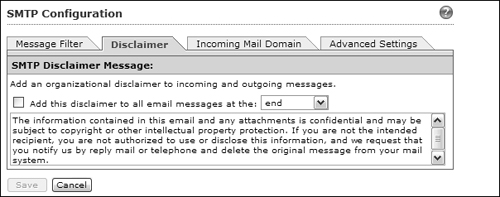
 Figure 12-34: Configuring the SMTP Disclaimer Message Parameters
Figure 12-34: Configuring the SMTP Disclaimer Message Parameters -
 Configure the Incoming Mail Domain tab.
Configure the Incoming Mail Domain tab. The CSC must be able to determine whether SMTP mail is incoming or outgoing when it applies various content detection and blocking functions. If you have SMTP servers inside your organization, then SMTP traffic will be incoming from the Internet toward those servers. The CSC looks at the domain names of e-mail recipients in incoming messages as it examines the e-mail content.
The CSC must be able to determine whether SMTP mail is incoming or outgoing when it applies various content detection and blocking functions. If you have SMTP servers inside your organization, then SMTP traffic will be incoming from the Internet toward those servers. The CSC looks at the domain names of e-mail recipients in incoming messages as it examines the e-mail content. You should add any domain names that are used inside your organization for email purposes. For example, if your users have e-mail addresses of the form username@mycompany.com, then enter mycompany.com as an incoming mail domain, as shown in Figure 12-35.
You should add any domain names that are used inside your organization for email purposes. For example, if your users have e-mail addresses of the form username@mycompany.com, then enter mycompany.com as an incoming mail domain, as shown in Figure 12-35.
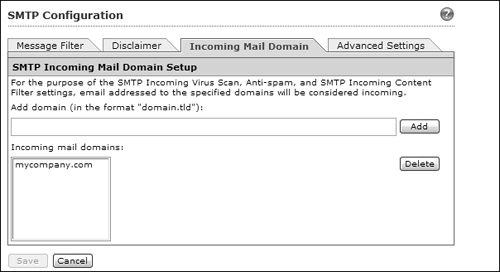
 Figure 12-35: Configuring the SMTP Incoming Mail Domain Settings
Figure 12-35: Configuring the SMTP Incoming Mail Domain Settings -
 Configure the Advanced Settings tab.
Configure the Advanced Settings tab. Malicious users can attempt to exploit SMTP connections as they set up an attack. The CSC can monitor the state of SMTP connections and take certain actions to mitigate an attack. You can configure the CSC to automatically time out idle SMTP connections after a time period (default 90 seconds) by adjusting the parameters shown in Figure 12-36.
Malicious users can attempt to exploit SMTP connections as they set up an attack. The CSC can monitor the state of SMTP connections and take certain actions to mitigate an attack. You can configure the CSC to automatically time out idle SMTP connections after a time period (default 90 seconds) by adjusting the parameters shown in Figure 12-36.
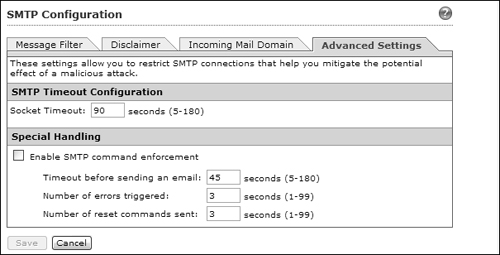
 Figure 12-36: Configuring SMTP Advanced Settings
Figure 12-36: Configuring SMTP Advanced Settings  You can also configure the CSC to close SMTP connections if any of the following conditions occur:
You can also configure the CSC to close SMTP connections if any of the following conditions occur:-
 Time elapses before a message is actually sent (default 45 seconds)
Time elapses before a message is actually sent (default 45 seconds) -
 A number of SMTP errors occur (default 3 errors)
A number of SMTP errors occur (default 3 errors) -
 A number of SMTP reset commands are sent (default 3)
A number of SMTP reset commands are sent (default 3)
-
Scanning POP3 Traffic
![]() The CSC can scan POP3 mail messages much like it scans SMTP mail. The main difference is that POP3 is used only when clients retrieve mail; SMTP is used when clients send mail. You can configure POP3 scanning by going to the Mail (POP3) > Scanning link and using the following steps:
The CSC can scan POP3 mail messages much like it scans SMTP mail. The main difference is that POP3 is used only when clients retrieve mail; SMTP is used when clients send mail. You can configure POP3 scanning by going to the Mail (POP3) > Scanning link and using the following steps:
-
 Configure the scanning target
Configure the scanning target Select the Target tab, as shown in Figure 12-37. First, set the maximum message size that the CSC allows. By default, messages larger than 20 MB are rejected. Next, choose the default type of file scanning. By default, the CSC scans all attachment files as they are sent through a POP3 connection. The CSC can also use its IntelliScan feature to scan files based on a “true file type,” which is determined by header information inside the files, rather than a filename extension. Otherwise, you can specify the filename extensions to be scanned.
Select the Target tab, as shown in Figure 12-37. First, set the maximum message size that the CSC allows. By default, messages larger than 20 MB are rejected. Next, choose the default type of file scanning. By default, the CSC scans all attachment files as they are sent through a POP3 connection. The CSC can also use its IntelliScan feature to scan files based on a “true file type,” which is determined by header information inside the files, rather than a filename extension. Otherwise, you can specify the filename extensions to be scanned.
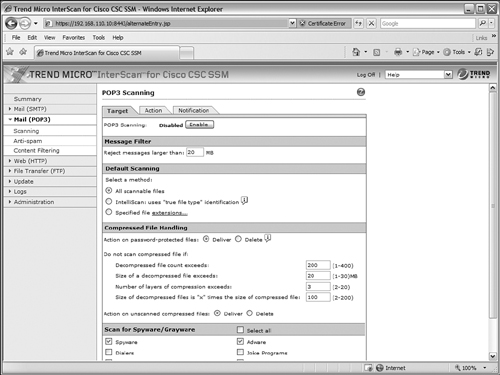
 Figure 12-37: Configuring POP3 Message Scanning
Figure 12-37: Configuring POP3 Message Scanning  Some attachments might be password-protected or compressed when they are downloaded. The CSC can attempt to scan these files, too. You can choose whether to deliver or delete password protected files. For compressed files, you can set limits on the extent of the file’s compression process to protect the CSC resources and the amount of time needed to download, uncompress, and deliver the files. Remember that the CSC has to download the complete file and then uncompress it before it can be delivered to the user.
Some attachments might be password-protected or compressed when they are downloaded. The CSC can attempt to scan these files, too. You can choose whether to deliver or delete password protected files. For compressed files, you can set limits on the extent of the file’s compression process to protect the CSC resources and the amount of time needed to download, uncompress, and deliver the files. Remember that the CSC has to download the complete file and then uncompress it before it can be delivered to the user. By default, password-protected files are delivered. Compressed files are scanned only if they contain less than 200 internal files, are less than 20 MB, require more than 3 compression passes, or are more than 100 times the size when uncompressed. If the compressed files are not scanned, they are still delivered by default.
By default, password-protected files are delivered. Compressed files are scanned only if they contain less than 200 internal files, are less than 20 MB, require more than 3 compression passes, or are more than 100 times the size when uncompressed. If the compressed files are not scanned, they are still delivered by default. You can also specify individual types of spyware and grayware content to be detected during FTP file scanning. By default, none of these types are detected. Be sure to click the Save button when you are finished configuring the Target tab.
You can also specify individual types of spyware and grayware content to be detected during FTP file scanning. By default, none of these types are detected. Be sure to click the Save button when you are finished configuring the Target tab. -
 Configure the action.
Configure the action. Select the Action tab. If an attachment is found to have a virus or malware, it can be cleaned (the default). As an alternative, the CSC can deliver the message after the offending attachment has been deleted, or it can deliver the original message intact—offending attachment and all.
Select the Action tab. If an attachment is found to have a virus or malware, it can be cleaned (the default). As an alternative, the CSC can deliver the message after the offending attachment has been deleted, or it can deliver the original message intact—offending attachment and all. With spyware and grayware, you can configure the CSC to deliver the offending files or delete them (the default).
With spyware and grayware, you can configure the CSC to deliver the offending files or delete them (the default). -
 Configure the notification.
Configure the notification. When the CSC detects suspicious content in an e-mail attachment file, it can send a notification. To configure this feature, select the Notification tab. By default, no notifications are sent by e-mail. However, you can choose whether to send e-mail notices to the CSC administrator (the e-mail address you configured for CSC notifications), the e-mail message sender, and the e-mail message recipient.
When the CSC detects suspicious content in an e-mail attachment file, it can send a notification. To configure this feature, select the Notification tab. By default, no notifications are sent by e-mail. However, you can choose whether to send e-mail notices to the CSC administrator (the e-mail address you configured for CSC notifications), the e-mail message sender, and the e-mail message recipient. By default, the CSC notifies the e-mail message recipient by inserting a descriptive message into the e-mail message text. You can also configure the CSC to insert a “risk free” message into the text of every message that has clean scanning results.
By default, the CSC notifies the e-mail message recipient by inserting a descriptive message into the e-mail message text. You can also configure the CSC to insert a “risk free” message into the text of every message that has clean scanning results.
Detecting Spam in POP3 E-mail
![]() The CSC can detect spam messages as they are retrieved through POP3 mail connections. Detecting spam in POP3 is a bit simpler than SMTP because e-mail messages are coming from a server toward the clients. With POP3, messages are always retrieved, so none of the parties involved can be a spam source; if spam exists, it is only as messages already queued for clients.
The CSC can detect spam messages as they are retrieved through POP3 mail connections. Detecting spam in POP3 is a bit simpler than SMTP because e-mail messages are coming from a server toward the clients. With POP3, messages are always retrieved, so none of the parties involved can be a spam source; if spam exists, it is only as messages already queued for clients.
![]() Under the Mail (POP3) > Anti-spam link, select the Target tab as shown in Figure 12-38. You can set the level of anti-spam detection in the Filter Threshold section. The higher the setting, the more likely spam messages are detected. However, the higher the setting also means a greater chance exists that the CSC triggers on false positives, or legitimate e-mail messages that it mistakenly labels as spam. If you find that a reasonable number of spam messages are getting through without detection, you can increase the filter threshold. Remember that POP3 anti-spam detection examines e-mail messages as they are received.
Under the Mail (POP3) > Anti-spam link, select the Target tab as shown in Figure 12-38. You can set the level of anti-spam detection in the Filter Threshold section. The higher the setting, the more likely spam messages are detected. However, the higher the setting also means a greater chance exists that the CSC triggers on false positives, or legitimate e-mail messages that it mistakenly labels as spam. If you find that a reasonable number of spam messages are getting through without detection, you can increase the filter threshold. Remember that POP3 anti-spam detection examines e-mail messages as they are received.
![]() You can also add specific e-mail addresses or domain names to a list of approved senders or blocked senders. If the sender’s address is found in the list of approved senders, the message is delivered without anti-spam detection. If the address is found in the list of blocked senders, all messages from that sender are dropped without delivery.
You can also add specific e-mail addresses or domain names to a list of approved senders or blocked senders. If the sender’s address is found in the list of approved senders, the message is delivered without anti-spam detection. If the address is found in the list of blocked senders, all messages from that sender are dropped without delivery.
![]() Under the Action tab, you can configure the action the CSC takes if it detects a spam message. By default, the message is “stamped” by having the text string Spam: added to the subject line. Stamping messages makes it easier for end users to create e-mail filters that can recognize the stamp string and take action automatically. Otherwise, you can configure the CSC to automatically delete spam messages before delivering them.
Under the Action tab, you can configure the action the CSC takes if it detects a spam message. By default, the message is “stamped” by having the text string Spam: added to the subject line. Stamping messages makes it easier for end users to create e-mail filters that can recognize the stamp string and take action automatically. Otherwise, you can configure the CSC to automatically delete spam messages before delivering them.
Filtering POP3 Content
![]() You can configure the CSC to filter POP3 messages according to specific things that are found in the message itself. Click on the Mail (POP3) > Content Filtering link, as shown in Figure 12-39.
You can configure the CSC to filter POP3 messages according to specific things that are found in the message itself. Click on the Mail (POP3) > Content Filtering link, as shown in Figure 12-39.
![]() You can configure the CSC to filter out messages that are larger or smaller than a given size. This can be handy to filter out messages that contain very large attachments. The CSC can also filter messages if it finds specific words in the subject line or the message body text. To accomplish this, enter the words in the Add words to subject filter field or Add words to body filter field and click on the Add button.
You can configure the CSC to filter out messages that are larger or smaller than a given size. This can be handy to filter out messages that contain very large attachments. The CSC can also filter messages if it finds specific words in the subject line or the message body text. To accomplish this, enter the words in the Add words to subject filter field or Add words to body filter field and click on the Add button.
![]() You can also configure the CSC to filter messages according to the attributes of attachments. For example, you can enter specific words or character strings to match against the attachment filenames. You can also select attachment file types to filter out.
You can also configure the CSC to filter messages according to the attributes of attachments. For example, you can enter specific words or character strings to match against the attachment filenames. You can also select attachment file types to filter out.
![]() Under the Action tab, you can choose whether to delete or deliver (the default) messages that are filtered. You can also select a text message to insert in the mail message to alert the user of the filtered condition. Finally, the Notification tab allows an alert to be sent to the CSC administrator when a message has been filtered.
Under the Action tab, you can choose whether to delete or deliver (the default) messages that are filtered. You can also select a text message to insert in the mail message to alert the user of the filtered condition. Finally, the Notification tab allows an alert to be sent to the CSC administrator when a message has been filtered.

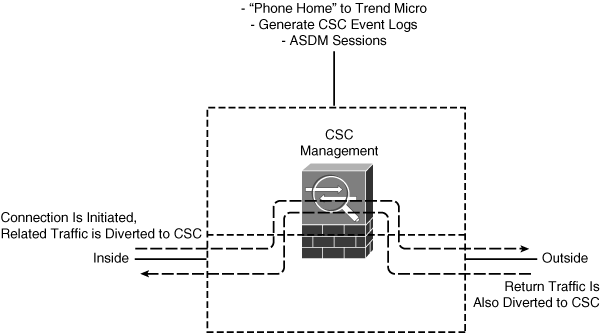
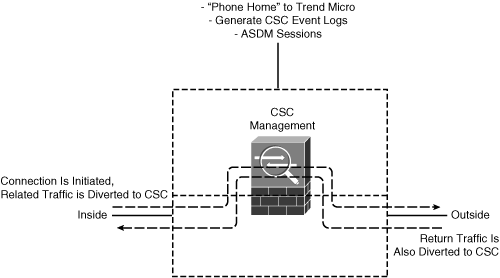
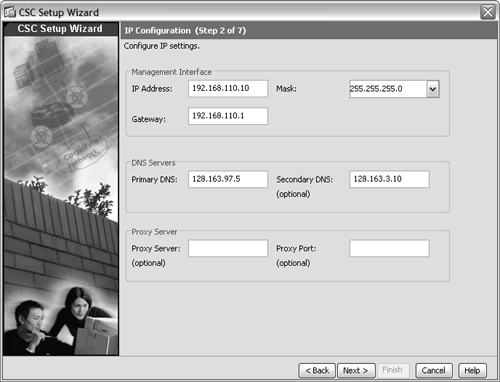
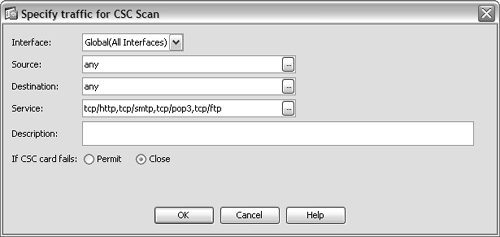
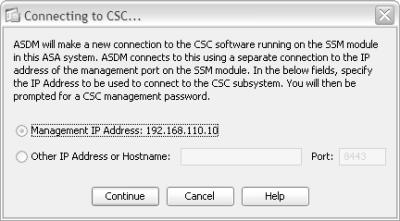
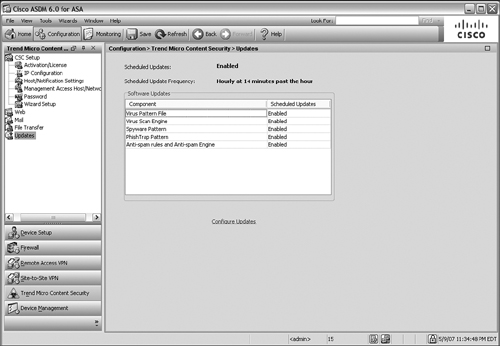
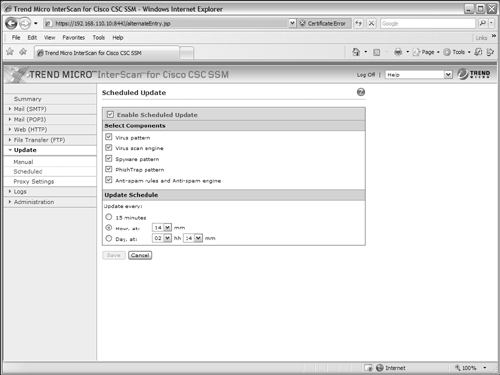
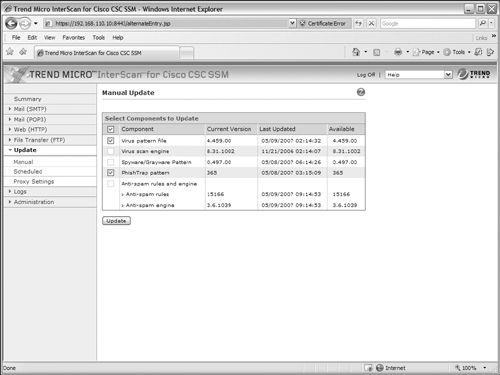
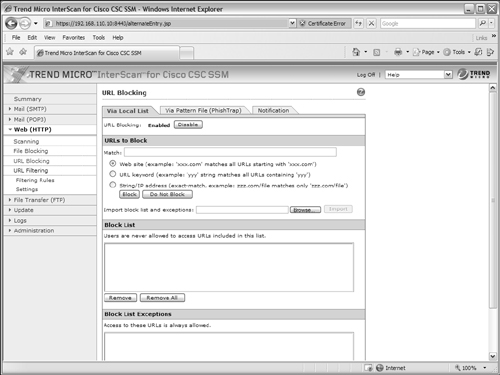

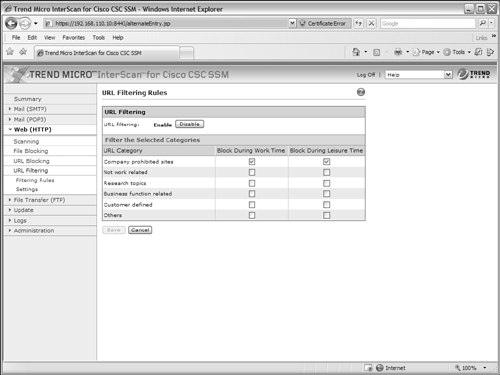
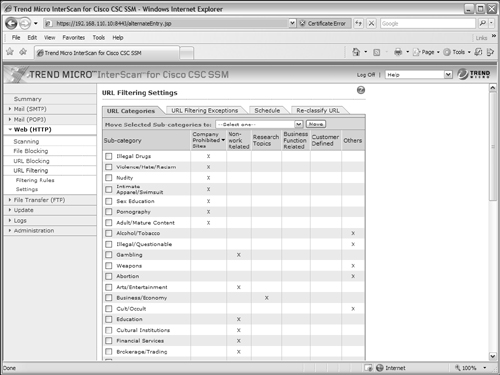
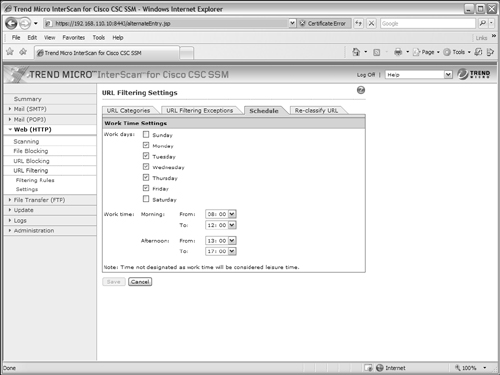
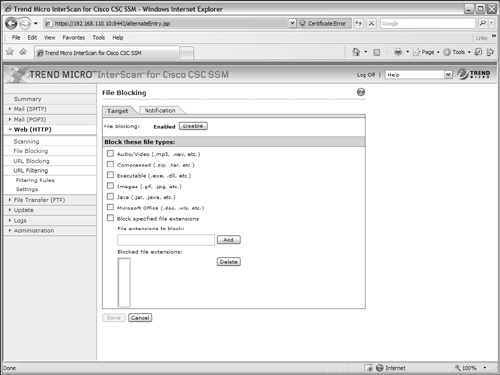





0 comments
Post a Comment